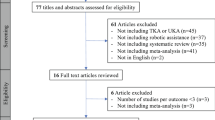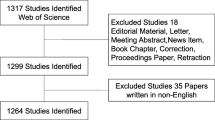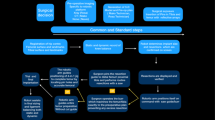Abstract
Purpose
Most opponents of assistive technologies in orthopedic surgery consider them as a marketing ruse or fashion. Our hypothesis was that many innovations in modern knee arthroplasty are not following the Scott Parabola. This parabola represents the visual curve of a procedure or therapy showing great promise at the beginning, becoming the standard treatment after reports of encouraging results, only to fall into disuse due to adverse outcome reports. This study aimed to assess the interest in these assistive technologies by (1) their number of publications/year and (2) their actual surgical use reported in the National Joint Registries.
Methods
The search was performed through PubMed, EMBASE, and MEDLINE databases from 1997 to 2021 inclusive to identify all available literature that described the use and results of assistive technologies or new surgical techniques in knee arthroplasty. In the Australian and Norwegian registries, the number of cases performed with these techniques in knee arthroplasty has been quantified year by year.
Results
Following the initial online search, a total of 4085 articles was found. After the assessment mentioned above, 2106 articles were included in the study. The orthopedic techniques assessed in this study are not following the “Scott’s parabola” in the literature. Computer-assisted knee arthroplasty and patient-specific instrumentation have increased quickly to have reached a plateau, with a stable number of publications over the last 6 years. The number of publications concerning robotic surgery, accelerometers and sensors continue to rise. In the Australian registry, the proportion of primary TKA performed by computer-assisted systems increased from 2.4% in 2003 to 32% in 2019. In the Norwegian registry, the proportion of computer-assisted TKA remained between 8 and 12% of primary TKA since 2007.
Conclusion
Most of the innovations in modern knee arthroplasty are not following the Scott Parabola. After a fast rise, these techniques do not disappear but continue to evolve. Their evolution is synergistic, and techniques appeared to be linked to each other’s. Despite persisting concerns about the cost-efficiency of assisting technologies in knee arthroplasties, the interest and use do not decrease and seems to be directly linked to an exponential increase in interest for a better understanding of alignment targets and improved functional recovery.




Similar content being viewed by others
References
Kurtz S, Ong K, Lau E, Mowat F, Halpern M (2007) Projections of primary and revision hip and knee arthroplasty in the United States from 2005 to 2030. J Bone Jt Surg Am 89(4):780–785. https://doi.org/10.2106/JBJS.F.00222
Gao J, Dong S, Li JJ, Ge L, Xing D, Lin J (2020) New technology-based assistive techniques in total knee arthroplasty: a Bayesian network meta-analysis and systematic review. Int J Med Robot. https://doi.org/10.1002/rcs.2189
Kawaguchi K, Michishita K, Manabe T, Akasaka Y, Higuchi J (2017) Comparison of an accelerometer-based portable navigation system, patient-specific instrumentation, and conventional instrumentation for femoral alignment in total knee arthroplasty. Knee Surg Relat Res 29(4):269–275. https://doi.org/10.5792/ksrr.17.032
Liow MH, Goh GS, Pang HN, Tay DK, Lo NN, Yeo SJ (2016) Computer-assisted stereotaxic navigation improves the accuracy of mechanical alignment and component positioning in total knee arthroplasty. Arch Orthop Trauma Surg 136(8):1173–1180. https://doi.org/10.1007/s00402-016-2483-z
van der List JP, Chawla H, Joskowicz L, Pearle AD (2016) Current state of computer navigation and robotics in unicompartmental and total knee arthroplasty: a systematic review with meta-analysis. Knee Surg Sports Traumatol Arthrosc 24(11):3482–3495. https://doi.org/10.1007/s00167-016-4305-9
Robinson PG, Clement ND, Hamilton D, Blyth MJG, Haddad FS, Patton JT (2019) A systematic review of robotic-assisted unicompartmental knee arthroplasty: prosthesis design and type should be reported. Bone Jt J 101(7):838–847. https://doi.org/10.1302/0301-620X.101B7.BJJ-2018-1317.R1
Onggo JR, Onggo JD, De Steiger R, Hau R (2020) Robotic-assisted total knee arthroplasty is comparable to conventional total knee arthroplasty: a meta-analysis and systematic review. Arch Orthop Trauma Surg 140(10):1533–1549. https://doi.org/10.1007/s00402-020-03512-5
Klasan A, Putnis SE, Grasso S, Neri T, Coolican MR (2020) Conventional instruments are more accurate for measuring the depth of the tibial cut than computer-assisted surgery in total knee arthroplasty: a prospective study. Arch Orthop Trauma Surg 140(6):801–806. https://doi.org/10.1007/s00402-020-03403-9
Yamamura K, Inori F, Konishi S (2021) Evaluation of the accuracy of resected bone thickness based on patient-specific instrumentation during total knee arthroplasty. Arch Orthop Trauma Surg. https://doi.org/10.1007/s00402-021-03805-3
DeFrance MJ, Yayac MF, Courtney PM, Squire MW (2020) The impact of author financial conflicts on robotic-assisted joint arthroplasty research. J Arthroplasty. https://doi.org/10.1016/j.arth.2020.10.033
Booth RE, Sharkey PF, Parvizi J (2019) Robotics in hip and knee arthroplasty: real innovation or marketing ruse. J Arthroplasty 34(10):2197–2198. https://doi.org/10.1016/j.arth.2019.08.006
Scott JW (2001) Scott’s parabola: the rise and fall of a surgical technique. Br Med J 323:1477
Foran JR, Whited BW, Sporer SM (2011) Early aseptic loosening with a precoated low-profile tibial component: a case series. J Arthroplasty 26(8):1445–1450. https://doi.org/10.1016/j.arth.2010.11.002
Kajetanek C, Bouyer B, Ollivier M, Boisrenoult P, Pujol N, Beaufils P (2016) Mid-term survivorship of mini-keel versus standard keel in total knee replacements: differences in the rate of revision for aseptic loosening. Orthop Traumatol Surg Res 102(5):611–617. https://doi.org/10.1016/j.otsr.2016.05.007
Jeon SW, Kim KI, Song SJ (2019) Robot-assisted total knee arthroplasty does not improve long-term clinical and radiologic outcomes. J Arthroplasty 34(8):1656–1661. https://doi.org/10.1016/j.arth.2019.04.007
Australian Orthopaedic Association National Joint Replacement Registry (AOANJRR) (2020) Hip, knee and shoulder arthroplasty: 2020 annual report. AOA, Adelaide, pp 1–474
Bergen H, Norwegian Arthroplasty Register (2020) Norwegian National Advisory Unit on arthroplasty and hip fractures 2020 annual report. Norwegian Arthroplasty Register, pp 1–377
Petursson G, Fenstad AM, Gothesen O, Dyrhovden GS, Hallan G, Rohrl SM et al (2018) Computer-assisted compared with conventional total knee replacement: a multicenter parallel-group randomized controlled trial. J Bone Jt Surg Am 100(15):1265–1274. https://doi.org/10.2106/JBJS.17.01338
Cip J, Obwegeser F, Benesch T, Bach C, Ruckenstuhl P, Martin A (2018) Twelve-year follow-up of navigated computer-assisted versus conventional total knee arthroplasty: a prospective randomized comparative trial. J Arthroplasty 33(5):1404–1411. https://doi.org/10.1016/j.arth.2017.12.012
Pagnano MW, Argenson JN, Parratte S, Scuderi GR, Booth RE Jr (2009) Minimally invasive total knee arthroplasty meets computer navigation. J Bone Jt Surg Am 91(Suppl):556–558. https://doi.org/10.2106/JBJS.I.00402
Murgier J, Clatworthy M (2020) Variable rotation of the femur does not affect outcome with patient specific alignment navigated balanced TKA. Knee Surg Sports Traumatol Arthrosc. https://doi.org/10.1007/s00167-020-06226-8
Moore RE, Conditt MA, Roche MW, Verstraete MA (2021) How to quantitatively balance a total knee? A surgical algorithm to assure balance and control alignment. Sensors (Basel). https://doi.org/10.3390/s21030700
Mooney LT, Smith A, Sloan K, Clark GW (2016) The effect of the native kinematics of the knee on the outcome following total knee arthroplasty. Bone Jt J 98(11):1471–1478. https://doi.org/10.1302/0301-620X.98B11.BJJ-2016-0144.R1
Boylan M, Suchman K, Vigdorchik J, Slover J, Bosco J (2018) Technology-assisted hip and knee arthroplasties: an analysis of utilization trends. J Arthroplasty 33(4):1019–1023. https://doi.org/10.1016/j.arth.2017.11.033
Antonios JK, Korber S, Sivasundaram L, Mayfield C, Kang HP, Oakes DA et al (2019) Trends in computer navigation and robotic assistance for total knee arthroplasty in the United States: an analysis of patient and hospital factors. Arthroplast Today 5(1):88–95. https://doi.org/10.1016/j.artd.2019.01.002
Klasan A, Meine E, Fuchs-Winkelmann S, Efe T, Boettner F, Heyse TJ (2019) Are serum metal ion levels a concern at mid-term followup of revision knee arthroplasty with a metal-on-metal Hinge design? Clin Orthop Relat Res 477(9):2007–2014. https://doi.org/10.1097/CORR.0000000000000638
Hamilton D, Howie CR, Gaston P, Simpson H (2012) Scott’s parabola and the rise and fall of metal-on-metal hip replacements. BMJ 345:e8306
Thienpont E, Schwab PE, Fennema P (2017) Efficacy of patient-specific instruments in total knee arthroplasty: a systematic review and meta-analysis. J Bone Jt Surg Am 99(6):521–530. https://doi.org/10.2106/JBJS.16.00496
Thienpont E, Schwab PE, Fennema P (2014) A systematic review and meta-analysis of patient-specific instrumentation for improving alignment of the components in total knee replacement. Bone Jt J 96(8):1052–1061. https://doi.org/10.1302/0301-620X.96B8.33747
Bonnin MP, Beckers L, Leon A, Chauveau J, Muller JH, Tibesku CO et al (2020) Custom total knee arthroplasty facilitates restoration of constitutional coronal alignment. Knee Surg Sports Traumatol Arthrosc. https://doi.org/10.1007/s00167-020-06153-8
Giannotti S, Sacchetti F, Citarelli C, Bottai V, Bianchi N, Agostini G et al (2020) Single-use, patient-specific instrumentation technology in knee arthroplasty: a comparative study between standard instrumentation and PSI efficiency system. Musculoskelet Surg 104(2):195–200. https://doi.org/10.1007/s12306-019-00612-3
Moerenhout K, Allami B, Gkagkalis G, Guyen O, Jolles BM (2021) Advantages of patient-specific cutting guides with disposable instrumentation in total knee arthroplasty: a case control study. J Orthop Surg Res 16(1):188. https://doi.org/10.1186/s13018-021-02310-y
Dalton DM, Burke TP, Kelly EG, Curtin PD (2016) Quantitative analysis of technological innovation in knee arthroplasty: using patent and publication metrics to identify developments and trends. J Arthroplasty 31(6):1366–1372. https://doi.org/10.1016/j.arth.2015.12.031
Funding
No funding was received.
Author information
Authors and Affiliations
Corresponding author
Ethics declarations
Conflict of interest
CB: Grant from SoFCOT. SP: Royalties from Zimmer Biomet and Newclip; Consultant for Zimmer Biomet; Treasurer for European Knee Society.
Ethical approval
Not applicable (publication metrics).
Informed consent
Not applicable (publication metrics).
Additional information
Publisher's Note
Springer Nature remains neutral with regard to jurisdictional claims in published maps and institutional affiliations.
Rights and permissions
About this article
Cite this article
Batailler, C., Parratte, S. Assistive technologies in knee arthroplasty: fashion or evolution? Rate of publications and national registries prove the Scott Parabola wrong. Arch Orthop Trauma Surg 141, 2027–2034 (2021). https://doi.org/10.1007/s00402-021-04051-3
Received:
Accepted:
Published:
Issue Date:
DOI: https://doi.org/10.1007/s00402-021-04051-3




